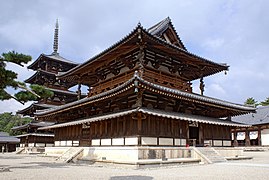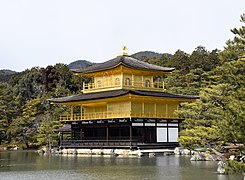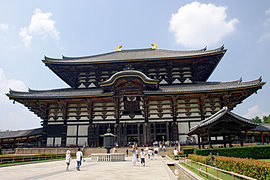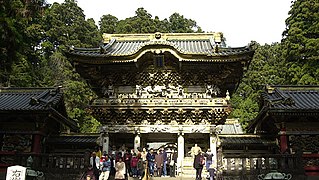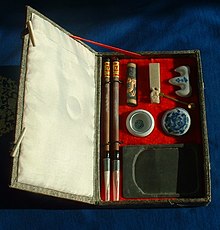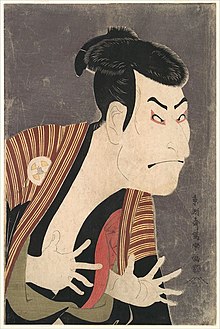Culture of japan
The culture of Japan combines many influences from Asia , Oceania and China as well as the western world . The voluntary isolation of Japan in the meantime and the special geographical location have emphasized some cultural features. Even if the closure of Japan was nowhere near as tight as is often assumed, it plays an important role in the self-image of the Japanese .
Cultural history
The roots of Japanese culture show similarities to both Southeast Asian tribes and Siberian tribes . Theories therefore place the origin of Japanese colonization in one of the two directions, most likely that Japan was colonized from both directions and a mixture took place. Evidence of this first culture are band ceramics, hence the name Jōmon culture . The Jōmon people probably immigrated to Japan from northeast Siberia, and a small number of Austronesian peoples came to Japan from the south .
In a second phase, the Yayoi culture, the first agricultural techniques ( dry field cultivation ) are proven. Historian Ann Kumar shows genetic and linguistic evidence that part of the Yayoi, possibly an elite group, was of Austronesian origin and came from Java Island to the Ryūkyū Islands and Japan via Taiwan .
During the Kofun period , Chinese and Korean immigrants brought a variety of innovations to Japan, in addition to rice cultivation , new techniques of house building and ceramics , bronze forging and the construction of barrows ( kofun ).
In the 7th century, with Korean Buddhist monks , the Chinese script , Chinese classics and Confucianism came to Japan in addition to religion .
In the Heian period it flourished for the first time, when the court nobility developed an independent poetry and literature from the Chinese heritage .
In the following epochs the country was repeatedly devastated by civil wars, whereby the sword nobility, the bushi, later referred to as samurai , became the most important class. In addition to the art of war and the art of swordsmithing, a new form of Buddhism, Zen , developed, which appealed to warriors.
It was not until the Edo period in the 17th century, under the Tokugawa , that the country came to rest again. The samurai became a class of officials who kept their warrior virtues in the martial arts, bujutsu or budo . The influence of Zen was now also reflected in poetry, garden art and music. The fourth class, the traders, also became wealthy during this period through peace and economic growth. Since they were denied social advancement, the traders looked to art for a way to outdo the samurai. They sponsored tea houses where the geishas practiced the tea ceremony , flower arranging , music and dance. They also sponsored the kabuki theater. In the cities, special entertainment districts formed, especially in Edo , where the daimyo had to spend half the year under the direct control of the Shogun .
Japan experienced a third heyday of culture in the post-war period, when Japan produced a lively pop culture that combines Western influences and Japanese tradition.
UNESCO World Heritage Site in Japan
Kinkaku-ji in Kyoto
The Fuji
- 1993: The Buddhist Shrines of Hōryū-ji
- 1993: Himeji Castle
- 1994: 19 monuments and gardens in Kyoto and Ōtsu
- 1995: Historical Villages of Shirakawa-gō and Gokayama
- 1996: The atomic bomb dome , the ruins of the Hiroshima Chamber of Commerce and Industry
- 1996: Itsukushima Shrine on Miyajima Island
- 1998: Monuments and gardens in Nara
- 1999: Temples and Shrines of Nikko
- 2000: Archaeological sites of the Ryūkyū Islands
- 2004: Holy places and pilgrimage routes in the Kii Mountains
- 2007: Iwami Ginzan Silver Mine in Ōda , Shimane Prefecture
- 2011: Hiraizumi temples, gardens and archaeological sites
- 2013: Fuji volcano
- 2014: silk mill and silk factory in Tomioka
- 2015: Sites of Japan's industrial Meiji revolution: iron and steel, shipbuilding and coal mining
- 2016: National Museum of Western Art , the architectural work of Le Corbusier
Language and writing
- Japanese language
- Japanese writing
- Japanese salutation
- Japanese name
- Japanese calligraphy ( Shodō )
literature
→ Main article: Japanese literature
Literary movements
Literary forms
Famous writers
→ Main article: List of Japanese writers
Poetry
→ Main article: Japanese poetry
to form
Important poets
Important collections
- Hachidaishū : Eight Imperial Waka Collections
- Man'yōshū
symbolism
religion
→ Main article: Religion in Japan
In Japan, several forms of religious belief have always coexisted. The most important are Shinto , which is derived from the original Japanese religion, and Buddhism , which reached Japan in the 5th or 6th century. In addition, there were Chinese influences through Taoism and Confucianism , which were taken up and integrated by Shinto and Buddhism. Today most Japanese belong to both main religions, so the basic religious attitude in Japan can be described as syncretic . The Christianity plays only a minor role in Japan's history. Since the end of the Second World War , there has been a particularly high level of religious tolerance in Japan: around 180,000 religious communities are currently listed as officially recognized.
See:
Martial arts and warrior culture
Everyday culture
The gift culture: Omiyage
On travel culture: Ryokan
hygiene
- Onsen (bath with hot spring)
- Sentō (traditional bath house)
- Toilets in Japan
Eating and drinking culture
Traditional Japanese cuisine works with what was found on the island. Rice (since the Yayoi period ), vegetables , fish (after all, the sea is nowhere more than 150 km away), beans , especially soy beans, millet , sweet potatoes and seaweed nori . Rice occupies a special position. Until the Meiji Restoration , farmers had to deliver their taxes in rice (measured in koku ). The value of the land was also measured by how much rice it yields. Because rice was so valuable as a means of payment, the farmers mainly ate millet.
Eating habits in Japan have been changing since World War II. The increased standard of living has resulted in rice becoming a staple food, but is now on the decline. The consumption of beef and pork has increased significantly.
The spread of fast food chains has another influence. In addition to American chains such as McDonald’s and Kentucky Fried Chicken, there are also many Japanese chains that either mimic Western chains or offer Japanese-style food, such as Yoshinoya .
Fruit is also grown in Japan, such as natsumikan , but the demand is not met, which is why a lot is imported. Japanese consumers are very demanding when it comes to fruit, only high quality is imported, so fruit is very expensive in Japan, e.g. B. Melons . Therefore, individually packaged fruit can be purchased as a gift in special shops.
Another specialty of Japanese food culture is the so-called Bentō box, packaged food for the lunch break at school or at the company. The food is artfully prepared in these boxes. The Bentō box is either prepared by a housewife or mother, as is customary in Japan, or it can be purchased in small Bentō shops.
The traditional alcoholic drink in Japan is sake , a rice wine. Sake is an offering to the gods in Buddhist and Shinto shrines. In the Meiji period , however, the first beer breweries also emerged, so beer is now popularly drunk. Plum wine is also popular with women. The Japanese like to have hot and cold snacks at drinking parties , which is why the izakaya , the Japanese pubs, also have a kitchen.
In Tokyo, Kappabashi Street functions in its entirety as a shopping street for restaurant and kitchen supplies.
Home decor
- Fusuma (sliding doors)
- Irori (recessed stove)
- Kotatsu (heated table)
- Shōji (sliding walls)
- Sudare (removable blinds)
- Tatami (straw mats)
- Tokonoma (traditional niche)
dress
- Geta (wooden sandals)
- Hakama (traditional trousers)
- Haori (formal jacket)
- Happi (jacket)
- Keikogi (sportswear)
- kimono
- Obi (belt)
- Tabi (socks with split toe)
- Waraji (straw sandals)
art
→ Main article: Japanese art
A geisha (literally "artist") is an entertainer who performs traditional Japanese arts. The famous Gion district in Kyoto is the center of Japanese geisha culture. The hard basic training of a maiko (geisha student) is possible from the age of about ten and lasts three years. During this time she learned the basics of traditional Japanese arts such as calligraphy , ikebana (flower arrangement) and playing several Japanese musical instruments, e.g. B. Shamisen , Hayashi flute and tsuzumi drum . A geisha must also be proficient in conversation and be a perfect singer, dancer and hostess and master the tea ceremony . The high costs of the training are borne by the owners of the ochiyas (Japanese tea houses ) and have to be repaid later by the geishas. Many geishas continue their profession into old age.
Art terms and aesthetic concepts
Painting and graphics
Fold paper
Origami (Japanese 折 り 紙, 'ori': to fold and 'kami': paper) is an ancient Japanese art of folding paper. Usually square sheets of paper are used as a starting point, and artistic motifs in three dimensions are created without the aid of scissors and glue. Well-known traditional motifs of origami are animals, birds, z. B. Tsuru ( crane ) and items like the kabuto (helmet).
characters
theatre
Flower arrangements
Ikebana (Japanese 生 花 also 生 け 花, literally living flowers) is the Japanese art of arranging flowers. It is also called Kado (Japanese 華 道, English way of the flowers). In contrast to the decorative form of flower arrangements in the western world, the ikebana creates a harmony of linear structure, rhythm and color. Where in the west the flowers are the main focus, the Japanese place value on the linear aspects of the arrangement. Vase, stems, leaves and twigs have the same status in this art as the flower.
Garden art
Japanese gardens are an expression of Japanese philosophy and history. In contrast to European gardens, hardly any flowers are planted, instead attempts are made to create a harmonious overall picture using moss, stones, trees and ponds, which also includes the surrounding scenery, such as the mountain slopes behind the garden. However, the lack of flowers does not mean that nothing blooms in Japanese gardens. In spring, plum , peach and cherry trees bloom one after the other . Koi fish are often kept in the ponds of the gardens .
Strongly influenced by the aesthetics of Zen Buddhism, there is a special form to which many of the most famous Japanese gardens belong, the Zen garden in the Kare-san-sui style, in which water and larger plants are completely dispensed with. In the tsukiyama style (artificial mound), on the other hand, mountains of stones and small mounds are represented, and a pond represents the sea to form a miniature landscape.
Garden art in small format are the bonsai (Japanese 盆栽), trees grown in a bowl, which are kept small and artistically shaped by cutting, root cutting and wiring . In Japan, bonsai are set up in the garden or in the tokonoma , a highlighted niche in the room. With good care, bonsai can be hundreds of years old and therefore very valuable. Pine, juniper, maple, Asian elm species, azaleas, fruit trees such as cultivated apples or Japanese apricots are traditionally grown as bonsai. In 1878, Japan presented bonsai to a Western public for the first time at the World Exhibition in Paris. After the Second World War, bonsai became a hobby all over the world. In Europe, species such as weeping fig, serissa, fukientee and the Chinese elm, which can also be kept in the room, have established themselves.
Ceramics
- Jōmon ceramic
- Yayoi ceramic
- Haji ceramics and Haniwa
- Sue pottery
- Hagi pottery
- Raku pottery
Tea ceremony
The Japanese tea ceremony (Japanese: sadō茶道), also known as the tea path and tea ritual, is closely related to Zen Buddhism in its underlying philosophy . It is a meeting following certain rules, at which one or more guests are served tea and light meals by a host . In order to offer the guest the opportunity to contemplate, the gathering takes place in a deliberately simply furnished tea house.
Traditional music
Traditional musical instruments
- Biwa , short-necked lute
- Hichiriki , cylindrical double reed instrument
- Kokyū , bowed long-necked lute
- Koto , vaulted board zither with 13 strings
- Kugo , historical angle harp
- Ryūteki , bamboo flute
- Sanshin , three-stringed long neck lute from Okinawa
- Shakuhachi , bamboo flute
- Shamisen , three-stringed long neck lute
- Shō , mouth organ
- Shōko , flat gong
- Taiko , group of large barrel drums
- Taishogoto , box zither with keyboard
- Tsuzumi , hourglass drum
- Wagon , vaulted board zither with 6 strings
Japanese classical music
Tattoo art
Tattoos (Japanese irezumi入 れ 墨) have a very long tradition in Japan. The beginnings probably go back to the Yayoi period . Later, at the beginning of the Edo period (1603–1868), tattoos were very popular among prostitutes, among others, as well as among workers. From 1720 the tattoo was used as a kind of branding for criminals, which meant that "decent" Japanese could no longer wear tattoos. Those who were drawn in this way could no longer integrate themselves into society, which led to the formation of a class of their own: the yakuza . Under the Meiji government , this practice was abolished in 1870, but tattoos were also completely banned, which was not repealed until 1948. Because of their association with the yakuza, many Japanese are reluctant to tattoo, and many public baths and onsen (thermal baths) deny entry to tattooed people.
Although stylistically very uniform, there is a great variety of motifs. Often there are mythological roots, such as dragons or demons, which often come from certain sagas and thus tell a whole story. Or there are symbols such as cherry blossoms (beauty and joy, but also transience) and Kois (success, strength and luck). The partly bloody and gruesome chopped off heads are interesting. These developed when horror stories became extremely popular in Japan towards the end of the 19th century; and particularly impressive and gruesome motifs from these stories were then captured on the skin.
In contrast to today's western fashion, it is not a tradition in Japan to have characters engraved.
architecture
See Japanese architecture .
Popular culture
watch TV
The Japanese television is subtitled almost always Japanese and works a lot with the medium of writing. The only public law organized Broadcasting Corporation 's NHK . It operates the channels NHK G (short for NHK General TV ; Japanese 総 合 テ レ ビ Sōgō Terebi , about general television ), NHK E (short for NHK Educational TV ; Japanese 教育 テ レ ビ Kyōiku Terebi , about educational television ), NHK BS1 and NHK BS Premium (Japanese NHK BS プ レ ミ ア ム Enu Eichi Kei Bī Esu Puremiamu ). There are also private providers such as Fuji Television , TV Asahi , Nihon TV and TBS . Japanese TV shows are usually moderated by a man who appears with a female sidekick .
Discussion boards are a popular format. In addition to the presenter, his sidekick and some well-known personalities, there is an expert in each of these programs. The group discusses a current issue together.
Another popular format, especially among private broadcasters, is game shows like Takeshi's Castle . The aim of the shows is only superficially to pass the tasks and to win as much prize money as possible. It is much more important that the candidate loses face in the most entertaining way possible. Therefore, the tasks in the shows sometimes seem very bizarre.
For Japanese series see also: Dorama .
Movies
→ Main article: Japanese film
Anime and Manga
Anime ( Japanese. アニメ , short for アニメーション Animēshon from English. Animation ) called in the German language in Japan produced animated films . In Japan itself, anime stands for all types of cartoons, for those produced in their own country as well as for imported ones. The most famous and most awarded anime studio is Studio Ghibli .
- Manga (jap. D , German about: casual / unbridled image): Japanese-style comics
- Cosplay : the desire to dress up
- Otaku : Intense fans of manga and anime
pop music
The Japanese pop music is very lively and local artists have a high market share. The spectrum ranges from teen bands to J-Rock and Punk (such as J-Ska ) to electronic music. With Enka there is also the equivalent of the hit for the target group over 50. It can be assumed that every trend in the international music business will also arrive in Japan or even emanate from there.
A special invention of the Japanese music business are the idols , teen idols created by agents who are also pop starlets, series actresses and models. Stars of this kind already existed with Pink Lady in the 1970s, long before test-tube bands were also successful in the European charts. The most famous Japanese idol group is AKB48 and is one of the most successful Japanese music groups ever.
See also:
Youth culture
Others
- Trading card games were very popular in the 2000s and, to a certain extent, were an integral part of everyday life. Meanwhile, their popularity has waned.
Sports, games and fun
Entertainment media such as video game consoles, gaming machines or similar types of entertainment electronics are to a large extent part of the generally recognized culture. In the 1990s and 2000s, video games were very popular and were bought in large quantities, especially by the young population. Meanwhile, the popularity of such games has waned with the appearance of the smartphone .
The pachinko machine is a slot machine with an extremely long tradition . This device is most likely to be compared with a vertical pinball machine - with the difference that after the ball has been pushed off individually, you cannot influence it any further. In Japan there are entire halls and floors filled with pachinko machines.
Popular sports in Japan
→ Main article: Sports in Japan
- Sumō ( 相 樸 ) is the Japanese national sport
- Baseball , see baseball in Japan
- Football is team sport number 2, at the latest since the football world championship 2002 , see football in Japan
- Martial arts, see portal: Budo , Karate (空手), Jūdō (柔道), Aikidō (合 気 道)
additional
Love and sex
- Chikan (groping in public)
- Etchi (euphemism for sex and all that has to do with it)
- Homosexuality in Japan
- Hentai (manga and anime with pornographic representation)
- Love Hotel ( Love Hotels)
- Omiai (marriage agency)
- Shibari (bondage art)
- Shinjū (joint suicide of two lovers)
economy
Curiosities and miscellaneous
- Hikikomori , sociological phenomenon
- Cool Japan , predicate for Japanese pop culture
- According to some statistics, the Japanese have the highest life expectancy in the world at 83.1 years
See also
Time calculation
additional
References
- Florian Coulmas: The culture of Japan. CH Beck, Munich 2003, ISBN 3-406-50916-9 .
- Christine Guth: Le Japon de la période Edo. Editions Flammarion, Collection Tout l'art, 1996, ISBN 2-08-012280-0 .
- Ursula Lytton: Death and Transformation - Study of a Religious-Aesthetic Concept in Japan , 6th Annual Conference, Yamagata University, Yamagata 1990.
- Miyeko Murase: L'art du Japon. Miyeko Murase, Editions LGF - Livre de Poche, Collection La Pochothèque, 1996, ISBN 2-253-13054-0 .
- Ienaga Saburō: Cultural History of Japan. Studies, Munich 1990.
- Christine Schimizu: L'art japonais. Editions Flammarion, Collection Vieux Fonds Art, 1998, ISBN 2-08-012251-7 .
- Kurt Singer: mirror, sword and precious stone. Structures of Japanese Life . Suhrkamp, Frankfurt / M. 1991, ISBN 3-518-11445-X .
Web links
- Japanese traditional culture, umbrella (in english)
- Hanami Web - Inside Japan (in english)
- JAPAN access German Japan portal u. a. with culture information
- The Library of Congress old Japanese drawings
- Japan Print Gallery commercial picture page
Individual evidence
- ↑ Noboru Adachi, Tsuneo Kakuda, Ryohei Takahashi, Hideaki Kanzawa-Kiriyama, Ken-ichi Shinoda: Ethnic derivation of the Ainu inferred from ancient mitochondrial DNA data . In: American Journal of Physical Anthropology . tape 165 , no. 1 , October 11, 2017, ISSN 0002-9483 , p. 139–148 , doi : 10.1002 / ajpa.23338 , PMID 29023628 , PMC 5765509 (free full text) - ( wiley.com [accessed June 19, 2018]).
- ↑ Choongwon Jeong, Shigeki Nakagome, Anna Di Rienzo: Deep History of East Asian Populations Revealed Through Genetic Analysis of the Ainu . In: Genetics . 202, No. 1, January 1, 2016, ISSN 0016-6731 , pp. 261-272. doi : 10.1534 / genetics.115.178673 . PMID 26500257 .
- ↑ John Travis: Jomon Genes: Using DNA, researchers probe the genetic origins of modern Japanese. Accessed June 19, 2018 .
- ↑ Hideaki Kanzawa-Kiriyama, Kirill Kryukov, Timothy A. Jinam, Kazuyoshi Hosomichi, Aiko Saso: A partial nuclear genome of the Jomons who lived 3000 years ago in Fukushima, Japan . In: Journal of Human Genetics . tape 62 , no. 2 , September 1, 2016, ISSN 1434-5161 , p. 213–221 , doi : 10.1038 / jhg.2016.110 , PMID 27581845 , PMC 5285490 (free full text) - ( nature.com [accessed June 19, 2018]).
- ^ Javanese influence on Japanese - Languages Of The World . In: Languages Of The World . May 9, 2011 ( languagesoftheworld.info [accessed July 25, 2018]).
- ↑ 崎 谷 満 『DNA ・ 考古 ・ 言語 の 学 際 研究 が 示 す 新 ・ 日本 列島 史』 (勉 誠 出版 2009 年) (in Japanese)

